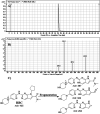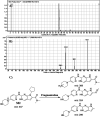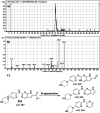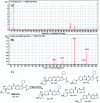In silico and in vitro metabolism of ribociclib: a mass spectrometric approach to bioactivation pathway elucidation and metabolite profiling
- PMID: 35514564
- PMCID: PMC9054585
- DOI: 10.1039/d0ra01624a
In silico and in vitro metabolism of ribociclib: a mass spectrometric approach to bioactivation pathway elucidation and metabolite profiling
Erratum in
-
Correction: In silico and in vitro metabolism of ribociclib: a mass spectrometric approach to bioactivation pathway elucidation and metabolite profiling.RSC Adv. 2020 Jun 23;10(40):23930. doi: 10.1039/d0ra90070b. eCollection 2020 Jun 19. RSC Adv. 2020. PMID: 35532509 Free PMC article.
Abstract
Ribociclib (RBC, Kisqali®) is a highly selective CDK4/6 inhibitor that has been approved for breast cancer therapy. Initially, prediction of susceptible sites of metabolism and reactivity pathways were performed by the StarDrop WhichP450™ module and the Xenosite web predictor tool, respectively. Later, in vitro metabolites and adducts of RBC were characterized from rat liver microsomes using LC-MS/MS. Subsequently, in silico data was used as a guide for the in vitro work. Finally, in silico toxicity assessment of RBC metabolites was carried out using DEREK software and structural modification was proposed to reduce their side effects and to validate the bioactivation pathway theory using the StarDrop DEREK module. In vitro phase I metabolic profiling of RBC was performed utilizing rat liver microsomes (RLMs). Generation of reactive metabolites was investigated using potassium cyanide (KCN) as a trapping nucleophile for the transient and reactive iminium intermediates to form a stable cyano adduct that can be identified and characterized using mass spectrometry. Nine phase I metabolites and one cyano adduct of RBC were characterized. The proposed metabolic pathways involved in generation of these metabolites are hydroxylation, oxidation and reduction. The reactive intermediate generation mechanism of RBC may provide an explanation of its adverse reactions. Aryl piperazine is considered a structural alert for toxicity as proposed by the DEREK report. We propose that the generation of only one reactive metabolite of RBC in a very small concentration is due to the decreased reactivity of the piperazine ring compared to previous reports of similar drugs. Docking analysis was performed for RBC and its proposed derivatives at the active site of the human CDK6 enzyme. Methyl-RBC exhibited the best ADMET and docking analysis and fewer side effects compared to RBC and fluoro-RBC. Further drug discovery studies can be conducted taking into account this concept allowing the development of new drugs with enhanced safety profiles that were confirmed by using StarDrop software. To the best of our knowledge, this is the first literature report of RBCin vitro metabolic profiling and structural characterization and toxicological properties of the generated metabolites.
This journal is © The Royal Society of Chemistry.
Conflict of interest statement
The authors declare no competing interests.
Figures














Similar articles
-
Piperazine ring toxicity in three novel anti-breast cancer drugs: an in silico and in vitro metabolic bioactivation approach using olaparib as a case study.Naunyn Schmiedebergs Arch Pharmacol. 2023 Jul;396(7):1435-1450. doi: 10.1007/s00210-023-02413-9. Epub 2023 Feb 4. Naunyn Schmiedebergs Arch Pharmacol. 2023. PMID: 36738368
-
Identification of Iminium Intermediates Generation in the Metabolism of Tepotinib Using LC-MS/MS: In Silico and Practical Approaches to Bioactivation Pathway Elucidation.Molecules. 2020 Oct 28;25(21):5004. doi: 10.3390/molecules25215004. Molecules. 2020. PMID: 33126762 Free PMC article.
-
Phase I metabolic profiling and unexpected reactive metabolites in human liver microsome incubations of X-376 using LC-MS/MS: bioactivation pathway elucidation and in silico toxicity studies of its metabolites.RSC Adv. 2020 Feb 3;10(9):5412-5427. doi: 10.1039/c9ra09115g. eCollection 2020 Jan 29. RSC Adv. 2020. PMID: 35498318 Free PMC article.
-
Detecting reactive drug metabolites for reducing the potential for drug toxicity.Expert Opin Drug Metab Toxicol. 2015;11(8):1281-302. doi: 10.1517/17425255.2015.1048222. Epub 2015 May 25. Expert Opin Drug Metab Toxicol. 2015. PMID: 26005795 Review.
-
Computational predictions of the site of metabolism of cytochrome P450 2D6 substrates: comparative analysis, molecular docking, bioactivation and toxicological implications.Drug Metab Rev. 2015 Aug;47(3):291-319. doi: 10.3109/03602532.2015.1047026. Epub 2015 May 29. Drug Metab Rev. 2015. PMID: 26024250 Review.
Cited by
-
Pharmacokinetics and pharmacogenomics of ribociclib in black patients with metastatic breast cancer the LEANORA study.NPJ Breast Cancer. 2024 Sep 30;10(1):84. doi: 10.1038/s41523-024-00692-w. NPJ Breast Cancer. 2024. PMID: 39349477 Free PMC article.
-
Active Compounds in Zingiber officinale as Possible Redox Inhibitors of 5-Lipoxygenase Using an In Silico Approach.Int J Mol Sci. 2022 May 29;23(11):6093. doi: 10.3390/ijms23116093. Int J Mol Sci. 2022. PMID: 35682770 Free PMC article.
-
LC-MS/MS Estimation of the Anti-Cancer Agent Tandutinib Levels in Human Liver Microsomes: Metabolic Stability Evaluation Assay.Drug Des Devel Ther. 2020 Oct 23;14:4439-4449. doi: 10.2147/DDDT.S274118. eCollection 2020. Drug Des Devel Ther. 2020. PMID: 33122888 Free PMC article.
-
Piperazine ring toxicity in three novel anti-breast cancer drugs: an in silico and in vitro metabolic bioactivation approach using olaparib as a case study.Naunyn Schmiedebergs Arch Pharmacol. 2023 Jul;396(7):1435-1450. doi: 10.1007/s00210-023-02413-9. Epub 2023 Feb 4. Naunyn Schmiedebergs Arch Pharmacol. 2023. PMID: 36738368
-
Development and Validation of a Rapid LC-MS/MS Method for Quantifying Alvocidib: In Silico and In Vitro Metabolic Stability Estimation in Human Liver Microsomes.Molecules. 2023 Mar 4;28(5):2368. doi: 10.3390/molecules28052368. Molecules. 2023. PMID: 36903615 Free PMC article.
References
-
- American cancer society,http://www.cancer.org/acs/groups/cid/documents/webcontent/003090-pdf.pdf
-
- National Campaign for Breast Cancer Awareness, http://www.moh.gov.sa/en/HealthAwareness/Campaigns/Breastcancer/Pages/st...
LinkOut - more resources
Full Text Sources

